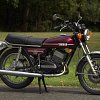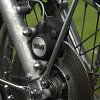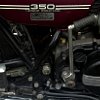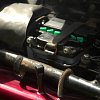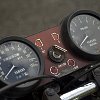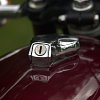If this was a serious motorcycle review, it would include a lengthy history of Yamaha and explain how the RD series is legendary. There would likely be some mention of the history of the moniker (RD stands for "Race Developed." Or it doesn't, depending on what you've read.) Your eyes would glaze, and you'd read… well, anything else.
But it's not a serious review.
It's a hacked-off report on what it is like to ride this weirdo ancient motorcycle — a 1974 Yamaha RD350 — today. I'm an over-the-hill rider (and writer, let's get the homophonic joke out of the way early) preaching to all seven of you who might listen to chatter about now-irrelevant Yamaha two-strokes. For those of you who have been reading the motorcycle rags for a long time, this may lead you to conclude this will be like a Kevin Cameron article. It is not.
Kevin's pieces are good.
Meet the 1974 Yamaha RD350
The RD's two-ingredient recipe made it popular in its heyday and is also why it remains desirable now: It's a two-stroke street bike that ain't a tiddler. Many riders in 2023 aren't old enough to remember when smokers ruled in the dirt, and even fewer can remember back to the days when you could see ring-a-dings on the pavement, but that's too bad: Two-strokes and tarmac are a magical combination. Back then, they were cheap. Today, they're rare. Both reasons contributed to the machines' popularity in the respective eras.
Two-strokes generally make tremendous power for their displacement; they're not unlike a rotary engine in that respect. They make a lot of (real good) noise. They also make a mess of the air. "If she ain't smokin', she's broken!" is more than just a bumper sticker. It's an accurate description of the theory of operation.

Due to the engines' outsized power, motorcycles with 2T powerplants fall into one of two camps: those that are regular-sized machines but absurdly fast (like the Kawasaki H2, the three-cylinder two-stroke from the 1970s, not today's supercharged four-stroke), or ones that are normally fast and absurdly small and light (this RD). The 39 horsies Papa Yam bestowed upon the RD sound modest, I know, but those ponies only had to motivate a motorcycle tipping the scales at 342 pounds. For comparison, after nearly 50 years of progress, a 2023 Kawasaki Ninja 400 makes about 43 ponies and weighs 366 pounds.
Factor in the temperamental power delivery on the '74 (nothing-nothing-nothing-wham! Holy Moses!) and the prehistoric-appearing chassis and brakes, and it becomes pretty obvious why this oil-burner acquired and maintained its reputation for punching above its (fly)weight. That said, I won't add to the lore: If my rear end is still calibrated correctly, the RD350 is not the fire-breathing monster some Boomer who was chucked off one loudly remembers it being. But it is exciting to ride.
Riding the Yamaha RD350
The Chef Boy feels antiquated from the moment it comes off the sidestand. (Chef Boy RD, get it? Say it out loud. The joke was awful half a century ago, and like the ravioli, it ain't getting better with age.) Fat, Coke-bottle grips feel like they come from another era, and the ergos, while not uncomfortable, just feel odd. Your feet are too far forward and up higher than you'd expect, and you can't really lock into the tank with your legs; you don't sit on or aboard this bike so much as you are seated in spite of it. Yamaha built it, and now you're here trying to sit on it and they simply did not plan for that. Sorry about the weird feeling.

Instruments are basic and have a few quirks. You got your usual speedo and tacho, and there's a horn and dip beam switch. There are also a few weird lighting peculiarities with an old RD. The first is an odd dashboard that offers a light to let you know when your brake lamp is lit. It sounds dumb, at first, but if you've ever ridden an old bike with ponderous brakes and brake switches that are operating on hope, you'll nod along when I mention how nice it is to actually know your brake light is blinking rapidly at the Subaru that looks like it's moving too fast in your mirrors.
Another feature I have always found a little quirky is the rear-facing turn signals that are red, not amber. And finally, headlights can be turned on and off via handlebar switch, another vestige from a time gone by.

Once you get done ogling all that stuff, you can flip out another anachronism, the starter lever. You'll be kicking this beast to life, though it's not hard at all, especially on this particular purple-petrol-eater; it's in top tune and feels like it might even start with a stern look. Yamaha offered the RD200B alongside this machine, and while it may have coughed up some displacement, it boasted an electric foot.
Editorially, I have absolutely no reason why that e-start version existed — every one of these RDs, R5s, or DS7s (the predecessors to the RD series and not really very different machines) I've ever ridden has needed very little in the kicking department. Usually you just need a few kicks and you're belching blue clouds.
Once it's running, you can let the choke off and deal with the first niggling problem feature characteristic of this thing: The idle speed is finicky. It needs constant fettling. And really, this is true of not just an RD, but of all two-strokes; They're incredibly sensitive to changes in temperature, humidity, and air pressure. Now, I'm not suggesting you need to carry a pocket full of jets as you are riding, but idle speed is not a Showtime Rotisserie Cooker.
Let me take a brief detour from this review for a moment. You know that thing you hear people do where they are just pointlessly revving when stopped? I have a theory: That habit grew from riders who had streetable 2T motorcycles. They load up with fuel at idle, plus you need to blip the throttle occasionally to get some oil flowing as you ride if you have autolube. (The RD series does indeed inject its own oil; just fill the tank, no mixing on your part is required.) Four-stroke riders just… copied it, and now it persists.

The RD requires some more pointless revving. On long stretches with the throttle closed (think a long hill descent), you have to remember to periodically clutch in and blip the go-tube, or minimal oil will make its way to the bottom end. And, of course, the engine will do very little to assist with decel. If you believe brakes are for slow and engine for go, a 2T is just the machine for you!
Let's pause the review for another moment. I am young enough that I only remember the era of two-stroke power being reserved for race machines, which are already bitchy and demanding. However, in the context of a bike one could (theoretically) have ridden to work during the week and on the track on the weekends, the RD's high-maintenance operating characteristics would require a patient rider. You might have already mentally signed out of this bike, and that would be 100% understandable. I've presented all the bad stuff up front, because it's really a trip to ride this while considering what a young, broke thrill-seeking purchaser of the era would want.
That's the part that actually gives this bike its reputation. Power. Fury. Riding an RD is a surprisingly visceral experience. Sure, it presents as a nice, generic-looking vintage bike. But it makes a nasty snarl when it comes to life, and though it is tiny, it is very apparent this thing will hurt you. I recall reading a passage about an RD250. I don't know who wrote it. I know not what publication printed it. But I am compelled to include it because this homage to Little Brother RD250 concisely describes the feelings of enjoying an RD for the first time. I've taken some liberties cleaning up the copy, but left the essence, I think.
"A whiff of throttle raises the exhaust note to an all-too-willing wail, and it's immediately obvious you've got some ponies beneath you. First gear is engaged with a bit of a clunk. A fistful provides the necessary revs imposed by the highish first gear, and you're off, wheel barely kissing the tarmac. Eight grand's reached in about as much time as it takes to throw out the clutch lever and wind the throttle drum back to the stop. Then it's hoick into second, the front end goes all light again, you're thinking 'Christ, and this is a 250?!' and the needle's nudging the redline again. Hoick into third, it's light but not so worryingly. You've time to watch the needle this time, then things are starting to steady up. It’s a bit of a struggle to reach the red, then into top gear and it's all over. You're at an indicated 90 mph, bolt upright and holding it! Get down on the tank and the speed's up to 100. Even allowing for the usual inexcusable Jap instrument error, that's quite some speed from a road-going 250 cc motorcycle."

The front brakes on these machines are a study in terrible feel. The 350 got a single, solid disk up front with awful master and slave piston ratios; the pads feel like wood and the lever is a switch. If you can modify anything you've learned about riding on a bike with even half-decent brakes and adapt to this shitty system, though, the bike actually doesn't stop badly, on account of its weight. Rears are pretty decent for being fairly small drummies.
So if you buy one of these, prepare to deal with front brakes that are utter dogshit for feedback (2/10) even though the actual stopping itself isn't half bad (7/10). The rear brake is peachy, but… it's a street bike and arguably the hooligan bike of its time, so that doesn't really matter now, does it? Who gives a shit what the brake in the back is doing?
And now, finally, handling: I’ve buried the lede a bit here. Actually, I buried it a lot. The handling!
It
is
…superb.
I am heavier than the average test rider Yam had imagined, but it doesn't matter. The fork springs are too soft and the rear springs are rock-hard and damping is terrible at both ends, but even that cannot change the fact that this light, nimble little chassis feels like it's on rails even when it's getting railed. It will change directions with little more than firm thoughts from its pilot. The RD is rolling proof that a bigger engine makes a bike faster at accelerating, but lighter weight makes a motorcycle faster at everything.
The wheelbase is 52.1 inches. Let's come back to that modern Ninja 400 from earlier. Certainly one would consider that Ninja a compact motorcycle, but even so it sits at 53.9 inches. The Ninja is an undeniably popular track and canyon-carvin' mount. Yet for a similar amount of money, you can go buy a bike that weighs less and makes more power… and the bike did this 50 years ago.

If we operate from the assumptions that for the average track rat or fast street guy, A) brakes and suspension are going to be tuned anyway, and B) the brakes and suspension are a hell of a lot easier to alter than the wheelbase, the RD makes a compelling argument for itself even in 2023. The Ninja is going to need a change in pads and has a far more workable suspension from the jump, whereas the RD would likely be better served with a complete fork swap, shocks, and aftermarket swingarm, but it's still not a complete laundry list, given the bike's age, now, is it?
Or you could simply buy an RD350 and a 100 gallons of gas, which would get you the requisite seat time to know how to exploit everything it had to offer and just learn to ride around the foibles. Even the skinny-ass 18-inch tires are perfectly workable if you pop for something good like Avon Roadriders. The peaky engine and the nimble feet of the RD are 100% worth the price of admission and more. And any other redeeming qualities the bike may have are icing on an already-delicious cake.

Final thoughts on the RD350
The RD is an exhilarating bike to ride. I love hearing one because they sound like they mean business, and they ride like they sound. These bikes are much less forgettable than similarly priced, more milquetoast antiques like the Honda CX500 or Kawasaki KZ650.
The RDs are generally reliable, but in 2023, they are verifiably old enough to be very cool antiques. If they act up, a fourth-grader can work on one. If you want a classic but you're showing your age a bit, they're light and easy to ride, and they have old-timey kickers but aren't a bear to kick.
Old guys will tell you stories about them, and young guys will ask you questions about yours. You don't have to premix your oil due to the autolube function, and by riding one of these old things, you can ensure at least one Christmas card will arrive in your mailbox each year from one of your parts suppliers.
Take one for a spin if you get the chance. For most of us, barring a buddy with a stupid-valuable 1970s-era H2, an old Yamaha RZ350, or a gray-market machine, this is the fastest two-stroke you'll ever get a chance to ride.































 Riders Plus Membership
Riders Plus Membership

